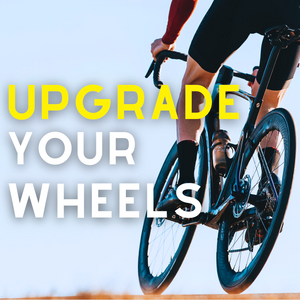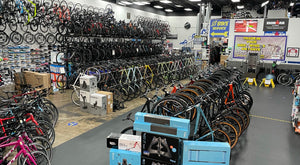At Playtri, we want to help YOU be the best Athlete YOU can be.
That means sharing our knowledge. We are professionals in various areas of multi-sport - whether you want to learn more about swimming, biking, running techniques, equipment care, training programs, or recovery techniques - we are happy to help! We also have many tips for first time triathletes. If you don't see a topic of interest, email us and we'll research and get back to you! There is probably another athlete with the same concern! info@playtri.com
Coaching and Workshops
Visit Playtri for information on coaching programs, then check with your Playtri Store for upcoming workshops and other events.
Blogs & Articles
COACH'S BLOG
ATHLETE'S BLOG
Videos
Visit Playtri TV on YouTube for the latest instructional videos, coach/athlete interviews and more!
First Timer Tips
Ready to Swim-Bike-Run?
Here are some helpful hints for first-time triathletes. You are only a newbie once…then you are a TRIATHLETE!
Triathlon might sound intimidating at first, but the truth is that if you know how to swim, ride a bike and run or even walk, then completing a triathlon is totally doable.
The sport is incredibly beginner-friendly, welcoming and immensely rewarding.
Why TRY a TRI?
Three reasons – variety, community, and fun! Maybe you’ve been running a while, but are looking for some variety. Maybe you swam as a kid and would love to try it again. Perhaps you love riding your bike for miles on end, but would like some company. Triathlon can do all of that for you, and while triathlons are competitions, the participants are incredibly supportive, encouraging and motivating. Triathlons themselves are usually weekend events, with a party-like atmosphere and family friendly fun.
For your fitness, triathlon training combines cross-training and cardiovascular benefits. It’s a great way to modify your training if the pounding of running is starting to bother your joints. By spreading your effort over three disciplines, you’ll minimize getting burned out, will improve flexibility and endurance, and will have found a sport that you’ll enjoy for a lifetime.
Starting to train for your first triathlon doesn’t require a huge investment. See the list of suggested race day equipment on our Race Day Checklist.
Choose a distance and give yourself time to train for it – the longer the distance, the longer the training period
There really is a triathlon for everyone. You’ll see four main distances, along with a ton of variations. For instance, super sprints are even shorter and are gaining in popularity. Pay attention to whether the swim is a pool swim or an open water swim as this is important for training and race day decisions.
The Most Common Triathlon Events & Distances
Super Sprint: 200-300 meter swim / 4-7 mile bike / 1-2 mi run
Sprint: 300 Meter Pool Swim or 500-750 Meter Open Water Swim / 9-15 Mile Bike / 3.1 Mile Run
Olympic: 1500 meter open water swim / 20-24 mile bike / 10K run
Half Distance or 70.3: 1.2 Mile Open Water Swim / 56 Mile Bike / 13.1 Mile Run
Full Distance 140.6: 2.4 Mile Open Water Swim / 112 Mile Bike / 26.2 Mile Run
There are a Variety of Other Formats Available
Aquabike
You’ll compete the swim and bike portions and head to the finish line. This is a great option for those who can’t or just don’t like running.
Duathlon aka Run-Bike-Run
Still three segments, but with a run-bike-run order. And no swimming if you don’t know how or aren’t ready yet.
Aquathlon
Just the swim and run, with no cycling.
Off-Road/Cross Country
Think mountain biking and trail running instead of paved roads.
Relay
These allow a team of two or three or even four athletes to compete.
Winter Triathlon
Running, mountain biking and cross-country skiing — all performed on snow (usually in colder climate areas).
Paratriathlon
Many races have a special category, or entire special events, for athletes with disabilities.
How Race Day Works
Triathlon involves a fair amount of logistics, planning and packing, but most race organizers do their best to make things as simple and smooth as possible.
Race checklists
Always check our Race Checklists before each race to ensure you're prepared with gear and other essentials before race day arrives!
Checking in/packet pick-up
Before the race, you’ll need to pick up your race number, swim cap, and stickers for your bike and helmet. Some races require that you check in the day before the race, while others let you do it all on race day. You’ll be storing your bike (called racking) and gear in a central “transition” area.
You’re going to swim first
You might swim in a lake, river, ocean or pool. Some events have you start in the water, lining up and treading water until the horn goes off. Or you might start on a beach and run into the water. Others have you jumping feet-first off the pool deck or a dock. Most people will be swimming freestyle, but you’re allowed to swim any stroke you like. You’ll be following a course, swimming from swim start to swim finish – be sure to review the course route to see if you go around buoys or do more than one loop.
Transition to the bike (T1)
After you finish the swim course, walk or jog to the transition area to get your bike. You’ll be barefoot, so watch your step! Change into your shoes, fasten on your helmet and walk/run your bike to the “bike out,” where you’ll be able to start riding AFTER you pass the “mount line.”
Transition to the run (T2)
You’ll be directed by volunteers to the “bike in,” and instructed when to dismount your bike and walk it back to your spot in the transition area. Remove your helmet, change to your running shoes (if you used cycling shoes on the bike), fasten on your race number, and head out for the run!
The finish line
Once you’ve crossed the finish line after the run, you’re done. Time to celebrate! After you’ve refueled and reveled in your awesomeness, you’ll need to head back to the transition area, pack up your gear, and retrieve your bike.
Setting Yourself Up for Success
Do some open water swim practice. It’s very different from pool swimming, and new triathletes often have anxiety about the swim. Check your Playtri store for upcoming events.
Practice transitions. Attend a transition clinic at your local Playtri. Practice in your front yard. Time spent in transition counts as part of your total race time.
Practice going from bike to run aka BRICK (Bike + Run + ick, get it?) Running directly after cycling feels very odd and the first 100 meters is usually the toughest.
Find a triathlon club or training buddy. Triathlon is better with friends! Training partners help get you through the tough training and it’s fun to compare notes at the end of the race.
Read the athlete guide and/or race website. Every race has one, and every race is different. It’s your responsibility to understand the schedule of events and rules.
Go to the athlete meeting. This is a great way to get a feel for the course conditions and anything weird that could surprise you on race day. Plus, you can ask questions.
Make a strong mental note of where your station is in transition – it can be a time-saver to know your spot. Before the race, make sure you know where you’ll be entering and exiting the transition area so you feel less pressured during the race.
Triathlon Lingo: Talk the Talk!
Aerobars: These special handlebars extend out from your bike and give you a place to rest your elbows. They offer a more aerodynamic, tucked position than can help you achieve faster bike times.
Age-grouper: Amateur athletes are called age-group athletes, competing with others in 5-year age and gender groups. Race age is determined by one’s age on Dec. 31 of the race year.
Body Marking: Race number on arm and leg with age on calf with temporary tattoo or black marker.
Brick: Combination workouts that include two disciplines back to back with minimal or no interruption, such as a bike followed by a run.
Clydesdale/Athena: Race award categories for men over 220 pounds and women over 165 pounds.
Cool-down: Physical activity done after a workout or competition to loosen muscles and rid the body of lactic acid.
Cross-train: To engage in various sports or exercises especially for well-rounded health and muscular development.
DNS/DNF: Did Not Start and Did Not Finish.
Drafting: Swimming behind a slightly faster person can save your energy, and is allowed. But drafting on the bike course — where you closely follow another athlete to reduce wind resistance — is only allowed in draft-legal races. In non-drafting races, participants must keep at least three bike lengths of clear space between themselves and the cyclist in front of them. If you move into the drafting zone, a rectangular area surrounding each bicycle, you must pass within 15 seconds.
Mount line: You can’t get on your bike until you cross this line.
Multisport: A sport consisting of more than one discipline, including triathlon, duathlon, aquathlon, aquabike, off-road triathlon and winter triathlon.
PR/PB: Personal record and personal best. Good for you!
Racking your bike: Placing your bike in the transition area on provided racks.
Sighting: Follow the swim course by lifting your eyes out of the water every stroke or two to see where you are in relation to the course buoys.
Speed laces: Elastic/bungee laces for your running shoes to save time tying them.
Swim waves: Based on gender, age and/or speed, you’ll start the swim with a subset of people, with your own starting horn. This is to space out athletes on the course.
Time Trial Start: Racers usually line up by their race number, and a starter has a racer begin every few seconds. Three second intervals are common. So, if there is a 500 person race, and racers begin every three seconds, it would take 25 minutes for every racer to enter the water.
Timing chip: You’ll wear a chip, attached to an ankle strap, through the whole race to track your time.
Transition (T1 + T2): Areas where your bike and gear are stored throughout the race. You’ll have an assigned spot. After each leg of the race, athletes return to transition to swap equipment before heading back onto the race course.
Trisuit: These are shorts and a top, or a one-piece style, that you wear through the entire race.
TT bike/tri bike: Special road bikes made for triathlon racing, with flat handlebars and a set of aerobars. They also have a different geometry than a road bike that engages your glutes more so it takes load off your hamstrings which is better for running after the bike.
Warm-up: To engage in activity before a race or workout. Warming up has a wide range of physiological and psychological benefits.
Wave Start: Perhaps the most common format for a triathlon start is a wave start. A wave start typically involves splitting into “waves” which are predefined by age group and gender. Different age groups often are given different colored swim caps. Elites and other special waves such as Clydesdales, Athenas, or teams may have their own waves. The wave is the same thing as a “heat”, and a typical wave will have anywhere from 15 to 50 people in it and start times are staggered by 2-3 minutes between waves.
Wetsuit: A close-fitting suit made of neoprene and worn by swimmers when they are in cold water to keep their bodies warm. Wetsuits also make you more buoyant and faster. USAT Competitive Rules state that competitors may wear wetsuits if the water temperature is 78 degrees Fahrenheit or lower; however age group participants cannot wear wetsuits in water temperatures equal to or greater than 84 degrees Fahrenheit. Check wetsuit rentals at your Playtri store.
Keep Learning
Want to learn more or ask other Triathletes for their input? Follow your Playtri store on social media and visit the Youtube Channel Playtri TV for more Triathlon 101 tips and tricks.
Come visit us at 6465 E Mockingbird Ln #358, Dallas, TX 75214, if you're looking for a top-notch bicycle store in Dallas.



